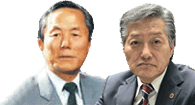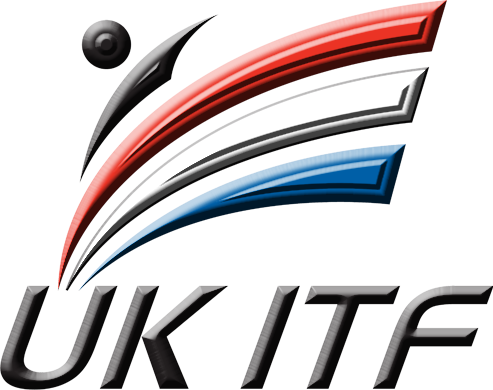U.T.A. National Seminar 23rd June 2007, Stevenage Arts and Leisure Centre:
The overall theme for the seminar was concentrated on “Power” and as such the event was later promoted to be –
“The Power Seminar”
The Five Disciplines:
The Seminar was broken up into five disciplines, Self Defence, Sparring, Breaking, Pad Work & Patterns. An explanation on how Power was to be introduced into these categories (especially sparring and patterns in which we seldom concentrate on generating full Power) was given by Mr Horan V, stating that Power can be achieved in all these elements of TaeKwon-Do providing the correct understanding of power is utilised.
The Warm Up:
Mr Darrin Bonfield IV warmed up the class (and instructors) with a blend of traditional and less usual warm up techniques.
The Seminar:
Self defence: Mr Steve Sharma III, Assisted by Mr Sam Sharma II
“Mass when you can, their mass when you can’t!”, “Direct attack when all else fails! and don’t forget those pressure points!!”
This aspect of the seminar concentrated on using your own mass with speed (to create power) whenever you can, opposing the opponents joints to create controlled pain and therefore effecting a release or a break. Where the opponent is much bigger than you and your attempts to use just your own mass fail, also attempt to use their own mass against them. Where the difference is just too great and you feel the use of your own mass or theirs will have little effect upon them, use a direct attack. Unfortunately the use of a direct attack in the simulation of self defence can sometimes be difficult for the opponent to believe how your action against them would have had an effect, an inner knife hand to the groin for instance when in a head lock, Mr Sharma used the careful use of pressure points in this situation to show that even the largest opponent will crumble when enough pain is directed in order to equal the balance! (and these can also be demonstrated in a safe way!)
Sparring: Mr Horan V
“Power for speed but don’t commit”
This aspect of the seminar concentrated on using techniques in a powerful way, with speed, until reaching the target in order to achieve a scoring point, but then withdrawing the attack before it reaches final commitment (the last 2” or so into the target). He described how on occasion a technique performed in such a way may shock you at first into thinking you have been hurt and your body reacts accordingly by tensing up and perhaps wincing, but then as you assess the damage caused by the blow you realise that in fact no damage was caused at all, the area hit may in fact not hurt at all or may just be stinging a little. All of us control this to some extent every time we score a point in sparring, even if we believe we haven’t and the opponent is stunned by a blow considered to be a little out of control, when this happens try to imagine that same technique fully committed and ask yourself, do I have any broken bones or damaged internal organs? If the answer is no that technique was executed in a controlled way to a certain point, we should all be proud of our self control when we consider our training in this way, as we in the U.T.A. have an exemplary low record of injuries that we are keen to maintain, well done to all!
Breaking: Mr Steve Miles IV and Mr Darrin Bonfield IV
“Power, technique but not too technical”
Breaking is the way TaeKwon-Do practitioners demonstrate their accuracy and power to the full, a technique used with too little power will simply not break the board or brick, conversely ten time the power required aimed at the wrong target will also not break the board or brick (more likely the practitioner!). In a controlled way the students were taken through ways in which their techniques could be modified slightly in order to produce more power when required for breaking, that isn’t to say practicing the pure techniques has been a total waste of time, this training has strengthened the practitioners joints and muscles to such a point that the technique can afford to be relaxed slightly to have a more devastating effect. In principal when we are breaking we are using all the same muscles used when performing the technique in it’s pure form but lessoning the emphasis on the opposing muscles we will need to keep the technique in check, this then makes the technique look more ‘sloppy’ which is why we don’t use them this way in patterns, after all by focussing less on the opposing muscle groups our equilibrium becomes impaired after the technique is executed, this would be no good within patterns as without the object to hit we would all too easily lose our balance! Using these adjusted skills quite a few people were surprised by themselves, and left the day haven broken something they were once certain they would never be able to do (and the day remained injury free!)
Pad Work: Mr Steve Fletcher II
“Practice breaking with a softer, bigger target and I don’t mean the pad holder!”
The first principals of breaking were demonstrating at the pad work section but without all the pain associated with getting things wrong! It was emphasised that team work must be used between pad holder and practitioner so that the practitioner was encouraged to try harder when appropriate but also to consider the person behind the pad and withdraw slightly if the pad holder felt uncomfortable receiving the full force of the technique. It was also highlighted that by holding the pad properly the pad holder would instil more confidence in the practitioner than if the pad were held sloppily or at the wrong angle etc. For those that had already visited the breaking section it was a chance to imagine the four bricks or eleven boards they would now be breaking if they went back there to try again!!
Patterns: Mr Andrew Botwright III
“Power within patterns within the constraints of beauty and pure technique”
It was described that we strive to produce as much power as we can within patterns whilst operating within the constraints of keeping the techniques we use as pure as possible, therefore maintaining equilibrium and making the whole process powerful and yet pleasing to watch. The students were asked to consider exactly where in space the object they were defending against or attacking is as they executed each move of the pattern and also to ensure each blow of their attack or defence always met the object at its most optimum point (the attacking tool having travelled the correct angle and distance). To aide this process each person conducting a pattern worked with a partner carrying a kick or focus pad whom then acted as the multiple opponents to which the pattern was being focussed. The partner ran between positions and placed the pad exactly where each attack or counter would be met, therefore allowing the pattern practitioner to use full power in each technique and to help them visualise this when conducting the patterns on their own in future training. It was explained that techniques such as reverse turning kick can use as near to full power as possible right up to 2” into the intended target, but then instead of dismissing the need to bring that technique back under control such as in breaking, utilise the opposing muscle groups at that point and retrieve the technique, overall slightly less powerful than the practitioner is capable of producing unhindered but powerful nonetheless. Training in this way also highlighted the difficulty most people had whilst visualising themselves as the opponents of someone performing a pattern, although they knew the pattern well that was being executed they had never before looked at the pattern from this vantage point, a quite disorienting experience. Most agreed it gave them a better understanding of the patterns and focus of the techniques in order to produce more power in the future.
The Whistle Blew:
Changeover between stations was controlled by the use of whistle blows, three to indicate 5minutes left, two to indicate time to summarise to the group or to allow the group to pad up ready for sparring if that was their next station and finally one to change stations, the last single whistle marked the end of a very enjoyable seminar.
Group photograph:
The end of another perfect day was marked by a group photograph (above centre) and thanks were given to all those whom participated and for the spirit they had shown throughout the day. We hope the students from the day tell others that missed the seminar how enjoyable the day was with a view to encouraging more students to attend the next event.
Acknowledgements:
Self defence: Mr Steve Sharma III, Assisted by Mr Sam Sharma II
Sparring: Mr Horan V
Breaking: Mr Steve Miles IV and Mr Darrin Bonfield IV
Pad Work: Mr Steve Fletcher II
Patterns: Mr Andrew Botwright III
Committee: And to all other Committee members who helped make this event possible
Ms Gloria Williams IV
Mr Dave Miles IV (Whom also organised Stevenage Arts and Leisure Centre)
Mr Michael Owen III
Mr Kalbinder Uppal III
Yours in TaeKwon-Do,
Andrew Botwright III
Public Relations Officer for the U.T.A.



 Log In
Log In
 Back
Back Write an Article
Write an Article Facebook
Facebook